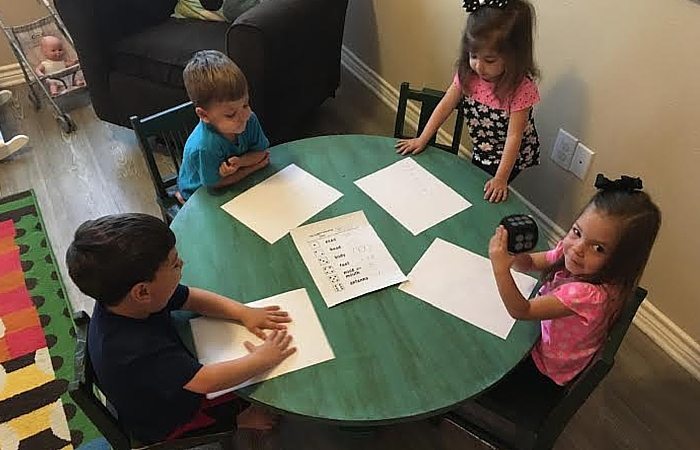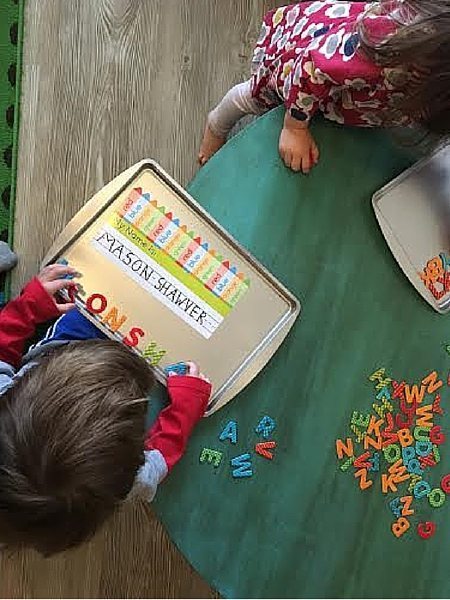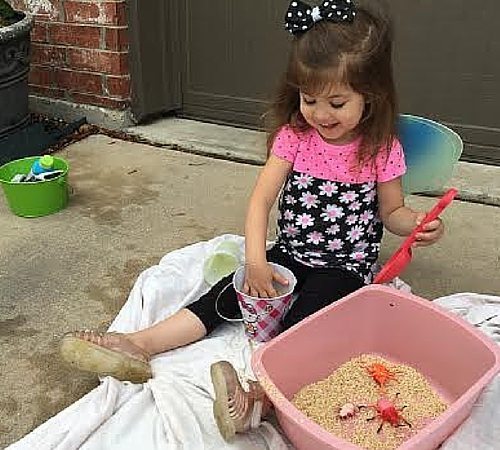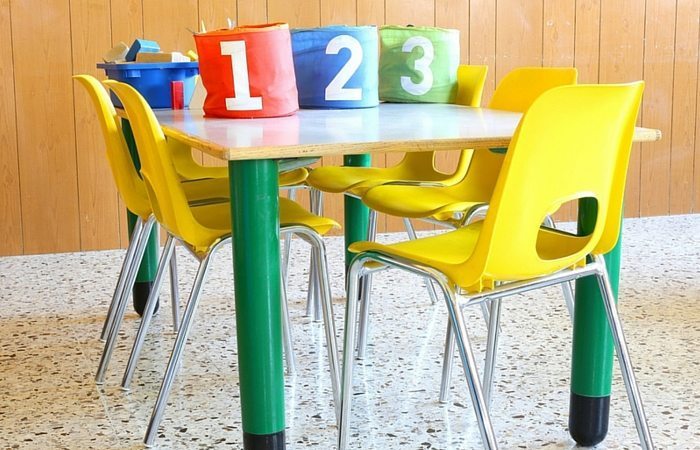Last updated on September 30th, 2021 at 10:11 am
When my kids turned three, I felt a sudden urgency for them to have a preschool experience that would prepare them for kindergarten. After considering cost and logistics of taking quadruplets to preschool, I decided to try my hand at homeschooling. For at least six months, Initially, I struggled to find a routine that worked for us, and I felt frustrated. Occasionally I pulled activities together, but it was inconsistent.
Eventually, I integrated three main components into our day, which made homeschooling work for us. First, we started getting ready for school, just as if we were preparing to leave the house for a traditional school. Before we begin school, we eat breakfast together, brush teeth/ wash faces, get dressed, make beds, and pick up the house. The kids could learn just as much in their pajamas, but getting ready for school helps everyone get in the school mindset.

Once it’s time for school, we begin circle time by using a playlist I created on Youtube, which consists of a variety of preschool learning songs (e.g. a gathering song, days of the week, months of the year, etc.). Prior to creating this playlist, starting circle time challenged me. The playlist helps me since I’m not great at carrying a tune or remembering lyrics, and it provides structure. Each song in our play list is close captioned and many include coordinated movements (this is also handy in case a babysitter is taking over for the day). Immediately following our morning songs, we go over the daily calendar. We have a magnetic Melissa & Doug calendar, which is easy to understand and discuss with young children.
Finally, much like traditional preschool classrooms, I integrated learning centers into our day. (Learning centers are typically set up in a classroom to encourage children to make choices. As they work in the centers they learn to work independently as well as cooperatively. This gives the child more control over what they do. Learning centers offer one easy route to addressing children’s individual learning styles. Source: Wikipedia)

For learning centers, I choose a variety of toys, games, and activities that we already have and put them in designated areas. I show the children what is in each center and allow about 10 minutes at each learning center before they rotate. Depending on what learning centers are available, the kids work in pairs or alone. Sometimes they enjoy being in learning centers alone because they have an opportunity to use toys or activities without having to share. At the same time, when they are in pairs, they have the chance to take turns and work together. During learning centers, I also seize the opportunity to work with one or two of the kids at a time on a particular skill through the use of an activity, craft, and occasionally a worksheet.
With these minor changes, a routine fell into place. We typically follow our homeschool routine twice a week, mirroring many traditional preschool programs, which are two to three mornings per week.
7:00 – Wake Up & Get Ready
9:00 – Circle Time (songs, weather, calendar)
9:15 – Storytime
9:30 – Learning Center Rotations / Structured Learning Activity
10:15 – Snack
10:45 – Clean Up
11:00 – Recess
12:00 – Lunch
12:30 – Free Play or Sensory Activity
1:00 – Quiet Rest Time
3:00 – Free Play
Since we are homeschooling, our schedule is quite loose. We always start with the same circle time routine, but make adjustments to time as needed. Even when we aren’t having official school time, the kids are constantly learning through play, listening to books, having conversations, and observing the world. In fact, our homeschool time is only responsible for a portion of the concepts and vocabulary my children know. Learning isn’t something that happens solely in a classroom, rather it is constant. For us, homeschooling is a means to hold me accountable for our children’s learning and to help them develop a familiarity with some components of a traditional classroom. The wonderful part about homeschooling is it can be tailored to the needs of each family!

If you are interested in homeschooling, there is a wealth of free resources available to parents and teachers of toddlers and preschoolers. Below are some of my favorite go-to websites for parents and teachers:
Confessions of a Homeschooler – a blog full of homeschooling ideas, resources and printables.
I Can Teach My Child – shares a variety of activities and themes to be used at home with children from birth to school age.
No Time for Flash Cards – provides an accessible resource for parents and teachers filled with multi-level, easy to follow, and fun activities for young children based on books and thematic units.
Pre Kinders – shares hands-on lessons, themes, printables, and activities with fellow Pre-K, Preschool, and Kindergarten teachers and parents.
Teaching Mama – provides tools for parents to enrich early childhood for their children.
The Measured Mom – provides free activities, lessons, and printables for teachers and parents
This Reading Mama – offers free printables, reading curricula, and literacy activities
Totschooling – shares creative early learning ideas, activities and resources with other parents of young children, especially with free printables
Pinterest helps me organize ideas and plans. I created multiple homeschool boards by topic:
Homeschool Preschool
Literacy
Numeracy
Motor Skills
Crafts
Science & Social Studies
Can I homeschool my 4-year-old?
The answer is absolutely! It may seem daunting at first, but we are parents of multiples, we can do anything! The skills we have acquired with parenting twins or more can be your greatest assets for homeschooling preschoolers. For example, organization and preparation are key for success in any preschool. As parents of multiples, we learned quickly that if we didn’t have our baby supplies in order and ready to go (diapers, wipes, bottles, milk, etc.) things did not go as smoothly (and made for cranky babies).
Another big part of teaching a preschool classroom is knowing the students and their individual needs. No one knows your children as well as you do! Also, keep in mind that teachers in a school setting are flexible with their plans and have backup activities on standby. Being parents of multiples we are masters at being flexible! We know things don’t always go as planned and have learned flexibility quickly.
Going along with the above-mentioned attributes, finding resources that make the most sense to you and your goals for educating your little ones will help you achieve homeschool harmony. Selecting the best curriculum and educational resources for you and your children can be a process. Hopefully, if you have a good idea of what you are looking for in a preschool homeschool curriculum, the process of choosing one will go smoothly.
What is the best homeschool curriculum for preschool?
Before you pick a preschool homeschool curriculum, really try to think and then make a list of some must-haves. Does it cover all the subject areas you’re looking for? Fine and gross motor skills, literacy, math, art, music and social and emotional. Are there some things that are non-negotiables for you? Do you want to incorporate religion? Are you looking for a curriculum that integrates naturally into daily life or something more structured? Are you looking for learning through play? I’m sure the list can go on, but definitely some questions to be asking yourself to get what you want and need out of a homeschool curriculum for preschoolers.
Another piece to keep in mind is state standards. Is the curriculum aligning with your state’s guidelines for early childhood education? Many states’ department of education websites should have their standards and benchmarks in a printable document that you can compare. See if the curriculum matches up to what your state outlines for preschool-aged children if it does not already tell you that it does. This is especially important if you are planning on sending your kids to public/private school for Kindergarten or later. Determine if the curriculum will set your children up to integrate into a public school setting comfortably.
As much as I would love to tell you that there is one great curriculum. I can’t. There is no “one size fits all” when it comes to education. You are the one that determines what is best for your children, which is a huge benefit of homeschooling your preschool-aged children, you get to decide! Also keeping in mind that there might not be one curriculum that fits every need, but the beauty of the internet is that it can support you to supplement lesson plans and activities with fantastic ideas. Another good resource would be if you know an early childhood educator. Most teachers would happily give you some tips in choosing the proper fit for your homeschool needs.
For a list of the ‘Top Ten Preschool Curriculum Options’ visit homeschool.com at https://www.homeschool.com/blog/2019/08/top-10-preschool-curriculum-options/
Can I homeschool my 5-year-old?
Like I said before, of course you can! I’m serious about this, parents you can do anything! Your 5-year-olds are growing and getting smarter by the day, so you need to keep up! If you homeschooled your preschoolers at 4 what kinds of things are you looking to do differently when it comes to their learning? Are you going to incorporate more field trips now that they’re older and more manageable in public? Thinking of your multiples and their personalities and needs, is focusing on social and emotional growth a must for them as they approach school age? Or are your kiddos socially adept and need some extra help with their academic skills?
With those questions in mind, we all know that our multiples are different from each other. One child might have different strengths and/or learning styles than the other one (not to compare, we never compare our children…. right, lol?) So how to tackle that beyond lesson planning and activities? Sometimes, the other child(ren) can be a good model. Also, you can try reaching out to find other homeschooling families in your area. Are there online or in-person groups you can join? If there are groups that meet in person, that could be a good way to have your preschoolers socialize with other children their age that are not their siblings. As we know from Twiniversity, community support makes a big difference!
What should I teach my 4-year-old at home?
Ah yes, what should I teach!?! This is a good time to check back into our list of what we are looking for in homeschool curriculum. Is there a good balance of the skills and subjects we are wanting in homeschooling our preschooler? If you have picked a curriculum that makes sense to you it should easily outline schedules, lesson plans, skills and activities.
A good curriculum will also differentiate instruction. That is a fancy teaching term that gives you lessons, activities, and ideas for children that are learning above or below the skill level being worked on. This is important for several reasons. One reason is if you have a child learning below the skill being taught it will give the building blocks to work up to that skill. Also, if you have a child that is exceeding skills and a quick learner, it should hopefully combat boredom and challenge the student. There won’t be differentiated instruction for everything, but seeing how the curriculum does it will give you good ideas so you can start coming up with/finding your own differentiated instruction.
Remember to not stress yourself out. I know easier said than done, but the good news is that you’re not reinventing the wheel here. There are many good resources to help create and round out the homeschool curriculum and experience you want for your preschool-aged children. Not into teaching music? See if the library is doing a free music classes weekly or biweekly to take the kids to! Are you observing that your kids have some gross motor needs you’re having a hard time fulfilling at home, look up if there are any open tumbling times at a local gymnastic center. When all else fails, there is always good ol’ Pinterest. The wonderful thing about being in complete control of the curriculum is tailor fitting it to your children, their needs, and life!

Amber Shawver and her husband, George, are the proud parents of girl-boy-girl-boy quadruplets who debuted in 2012. In an effort to maintain professional skills and a stitch of sanity, Amber continues to practice school psychology part-time. She finds that her professional training and experience are often handy managing the quads at home. In her spare time, Amber chronicles life raising quadruplets on her blog, Four to Adore. You’ll also find Four to Adore on Facebook, Twitter, and Pinterest. For more articles by Amber on Twiniversity, click here.
With additional contributions by…

Related Articles
Twins In School: Individuals, But Undivided







